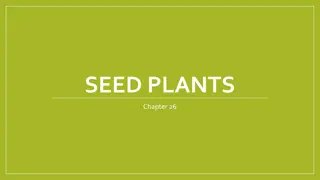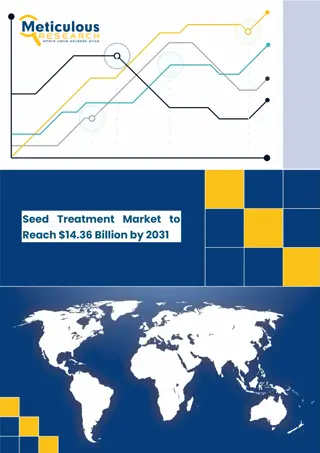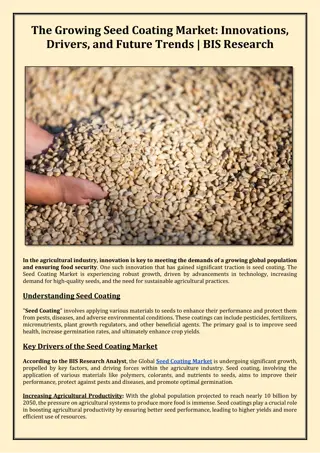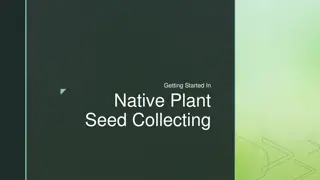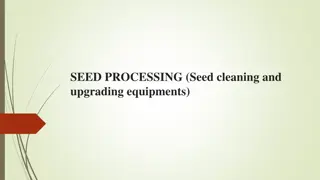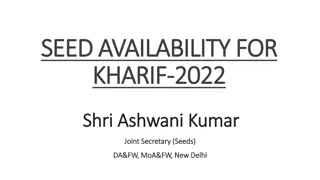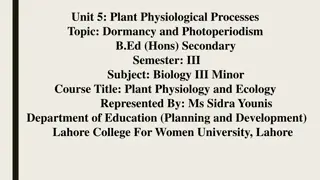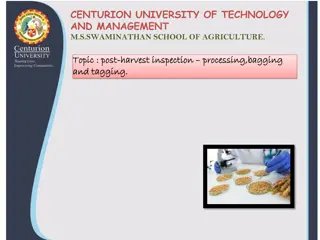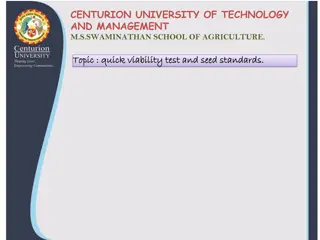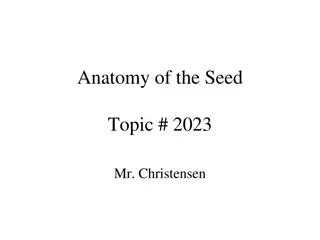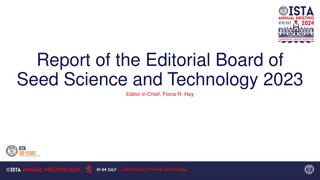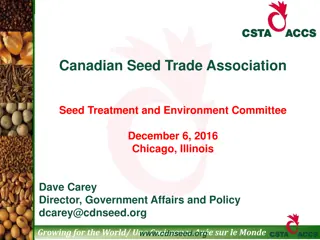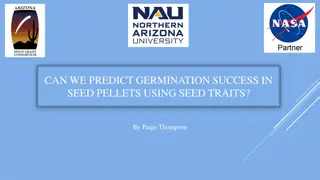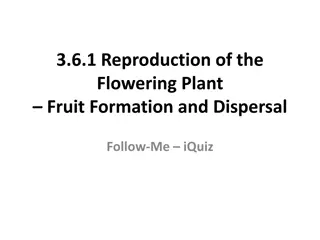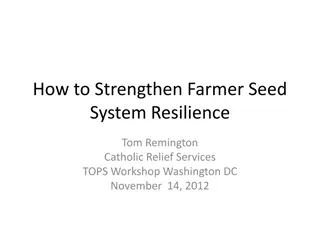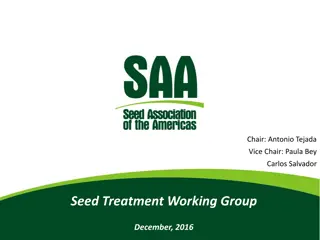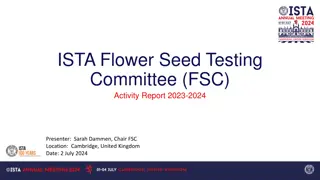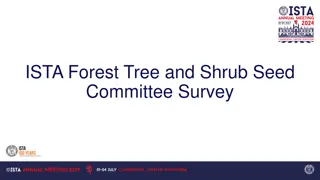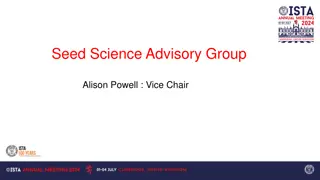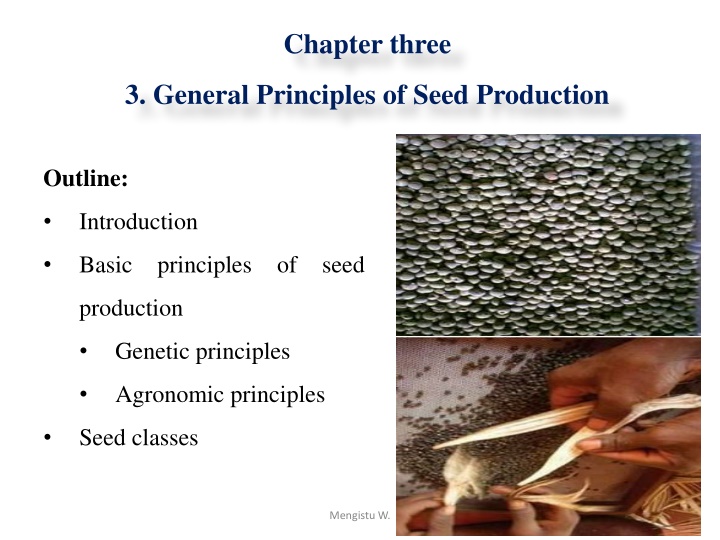
Principles of Seed Production: Genetic and Agronomic Insights
Explore the fundamental principles of seed production, covering genetic and agronomic aspects. Learn about methods of reproduction, self-pollinated and cross-pollinated crops, and the genetic makeup of seeds. Discover the necessity for technical skill in producing genetically pure seeds under organized conditions.
Download Presentation

Please find below an Image/Link to download the presentation.
The content on the website is provided AS IS for your information and personal use only. It may not be sold, licensed, or shared on other websites without obtaining consent from the author. If you encounter any issues during the download, it is possible that the publisher has removed the file from their server.
You are allowed to download the files provided on this website for personal or commercial use, subject to the condition that they are used lawfully. All files are the property of their respective owners.
The content on the website is provided AS IS for your information and personal use only. It may not be sold, licensed, or shared on other websites without obtaining consent from the author.
E N D
Presentation Transcript
Chapter three 3. General Principles of Seed Production Outline: Introduction Basic principles of seed production Genetic principles Agronomic principles Seed classes Mengistu W.
Introduction Methods of Reproduction The method of reproduction in crop plants broadly grouped into two: asexual/vegetative and sexual. Modes of Pollination Pollination refers to the transfer of pollen grains from anther to stigma. Pollen from an anther may fall on stigma of the same flower leading to self-pollination or autogamy. When pollen from flowers of one plant are transmitted to stigma of another plant, cross-pollination or allogamy. Mengistu W.
Self-Pollinated Crops Have hermaphrodite flowers But in most of these species, self-pollination is not exclusive and cross-pollination may occur up to 5%. Partial list of self-pollinated vegetables Tomato (Lycopersicon esculentum) Lettuce (Lactuca sativa) Parsnip (Pastinaca sativa) Peas (Pisum sativum) Dwarf bean (Phaseolus vulgaris) Mengistu W.
Cross-Pollinated Crops The majority of the cultivated vegetable species are cross-pollinated crops. Cross-pollination may occur both in bisexual and unisexual flowers but it is the rule in unisexual flowers. Agents: Wind e.g. Amaranthus, spinach, beet Insects: e.g. All cucurbits, all brassica, onion, carrot. Cabbage ( Brassica oleracea var. capitata) Cauliflower (Brassica oleracea var. botrytis) Broccoli (Brassica oleracea var. botrytis) Brussel s sprouts (Brassica oleracea var. gemmifera Knol khol (Brassica oleracea var. caulorapa) Carrot (Daucas carota) Radish (Raphanus sativus) Beet (Beta vulgaris) Spinach (Spinacea oleracea) Cucumber (Cucumis sativus) Watermelon (Citrullus lanatus) Pumpkin (Cucurbita moschata) Squash (Cucurbita pepo) Onion (Allium cepa) Mengistu W.
Basic principles of seed production The seeds of different crops have different behavior both in their genetic makeup and their response to the environment Those seeds from cross pollinated plants have higher potential for genetic mixing up than self-pollinated crops Production of genetically pure seed requires high technical skill and specialization. Mengistu W.
Cont.. Seed production must be carried out under standard and well-organized conditions. Moreover, producer should be familiar with genetic and agronomic principles of seed production Therefore, there is always a need to have guiding principles of producing seeds Mengistu W.
Genetic Principles It involves all the factors which may lead deterioration of genetic purity (true-to-type) of a crop variety. All seeds used for sowing must have similar genetic constitution for uniform performance and quality produce. Permanent reduction either in the genetic or agronomic value of a released variety is known as varietal deterioration. During the course of seed production, it is necessary to ensure that the product is true-to-type. Mengistu W.
Cont.. Genetic purity of a variety can be deteriorated due to several factors Genetic impurity causes genetic deterioration Not only impurity but also there is always other causes of genetic deterioration Such genetic degradation occurs during the cycles of seed production and farmer to farmer diffusion Mengistu W.
Developmental Variations Seeds of any given varietyhas the expected genetic makeup and acceptable quality when grown in its suitable environment But a shift in the environment can degrade both genetic behavior and quality Factors affecting plant growth and development include Edaphic (soil related ) Climatic (temperature, precipitation, humidity and evapotranspiration), Elevations Biotic (diseases, insect pests, weeds, beneficial microorganisms and animals like human, livestock and others) Mengistu W.
Cont.. When any variety is exposed to an unsuitable environment: The beneficial traits (behavior of the variety for which breeding is done) may not be well expressed due to environmental suppression It cannot give the expected yield and quality seed Mengistu W.
Mechanical mix-up (Varietal mixture) Mixing up of seeds of different varieties usually of a crop species Such mixing up of seeds of different varieties occurs during: Sowing, harvesting or storage Volunteer plants of the same crop Seed distribution, cleaning and transportation Seed dispersal by wind, rodents and other carriers Mengistu W.
Cont.. This happens when the seeds of the different varieties are difficult to separate because of their color and/or size Rouging the fields critically and using utmost care during seed production and processing are necessary to avoid such mechanical contaminations. Mengistu W.
http://t2.gstatic.com/images?q=tbn:ANd9GcSVbj4QQMFYh0rBYt-atk7jpdKrynASfysBihvUGFY_YQldroHKYzfPAmU_http://t2.gstatic.com/images?q=tbn:ANd9GcSVbj4QQMFYh0rBYt-atk7jpdKrynASfysBihvUGFY_YQldroHKYzfPAmU_ http://t0.gstatic.com/images?q=tbn:ANd9GcTVin6ANvB_1aYqkjUz000XPNLLD0WOEgT-63hdgAyyGeiWUG3wXRiETPM Natural crossing Important source of varietal deterioration in sexually propagating crops. major source of deterioration in cross fertilized crops. Such crossing is not intentional and occurs naturally by wind and insects The extent of such crossing depends on the magnitude of pollination system of the species, isolation distance, varietal mass, and pollinating agent. Mengistu W.
Use of non-refreshed seeds of variety staying on production for long time When a variety stays at production for long time, it faces different environmental condition from season to season Such variation on environmental condition causes genetic deterioration Exposition to different environmental condition may also result in mutation of the varieties Seeds produced long time before may not have the necessary behaviors due to reduction in viability and attack by weevils Mengistu W.
Minor genetic variations Can occur even in varieties appearing phenotypically uniform and homogeneous when released. Due care during the maintenance of breeder seed of cross fertilized varieties is necessary Mengistu W.
Selective influence of diseases Infected by disease to which it was considered resistant at the time of its release. This can result either because of; absence of such disease in the area where the variety was tested or Formation of new races of a disease Seed production under strict disease free conditions is, therefore, essential. Mengistu W.
Technique of the plant breeder Premature release of varieties (still segregating for resistance and susceptibility to disease or other factors) Break down in male sterility and other heritable variations Mengistu W.
Maintaining the genetic purity The important safeguards for maintaining genetic purity during seed production are : Control of seed source Use approved seed during seed multiplication It is critical to utilize a seed of an appropriate class and from an approved source Mengistu W.
Inspection and approval of fields prior to planting To check for the presence of volunteer crops, weeds and disease history To test adaptability, nutritional status, soil born disease and pest Mengistu W.
Crop Rotation Satisfactory intervals between related or similar crops is required to minimize the risk of plant material or dormant seeds remaining from the previous crops They are likely to cross-pollinate or make admixture with the planned seed crop. Also helps to enhance plant nutrition, maintenance of soil physical condition and minimizing the risk of soil-borne pests and diseases. Mengistu W.
Isolation Helps to ensure that the possibility of cross-pollination between different cross-compatible plots or fields is minimized. Adequate isolation avoids admixture during harvesting and the transmission of pests and pathogens from alternative host crops. Horticulture seed crops can be isolated by time and by distance Mengistu W.
Temporal /Time isolation One crop is grown and timed to flower before other crops reach the reproductive stage Two crops can be grown/planted side by side and, therefore, facilitates seed production by small farms (no big requirement for distance isolation) Requires irrigation facilities There is no pressure for labor among different crop fields Mengistu W.
Distance Isolation The minimum isolation distance required depends on whether the crop is cross-or self-pollinated wind or insect pollinated Self-pollinated crops/cultivars do not normally require isolation but seed fields must be separated by a few meters from the fields growing crops of the same spp. Cross-pollinated crops (isolation is more critical) Mengistu W.
Cont.. Insect cross-pollinated vegetable crops like onion, radish, cabbage, cauliflower and cucurbits require isolation distance of 800-1000 meter While wind pollinated vegetables like spinach, beet require isolation distance of about 2000 meters. Isolation distance also varies according to category of seeds like foundation and certified seeds ( Table 1). Mengistu W.
Table 1. Minimum isolation distance requirements for vegetable seed crop Mengistu W.
Rouging off Seed Crop The existence of off-type plants in the seed crop is a potential source of genetic contamination. Not only the off-types but the diseased and abnormal plants are also to be removed. Rouging may be done at any stages as soon as the off-types are recognizable: Vegetative stage Flowering stage Maturity stage Mengistu W.
Cont.. Periodic testing of varieties for genetic purity Varieties being grown for seed production should periodically be tested for genetic purity by grow-out tests to make sure that they are being maintained in their true form. Growing crops in areas of their adaptation It is important to cultivate each crops in their suitable environmental conditions Mengistu W.
Seed Certification: The genetic purity in the commercial seed production is maintained through a system of seed certification. The crop and seed lot have been duly inspected and that they meet requirement of good quality pedigree seeds. Mengistu W.

